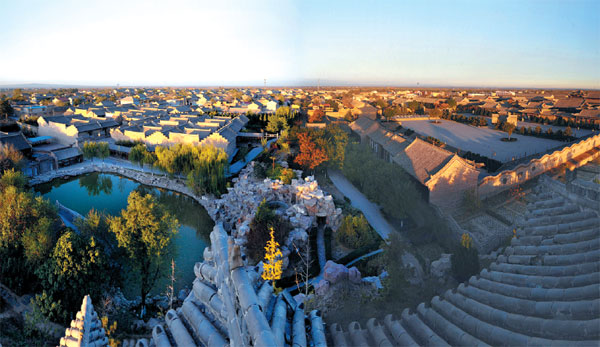A philanthropic family's old mansion shows what wealth and poverty meant in bygone eras. Sun Ruisheng reports in Wanrong, Shanxi.
Shanxi province was celebrated as a hub of tycoons from the 19th century to early 20th century, and many of their mansions remain icons - but few people know about the Li Family Courtyard in Yuncheng city's Wanrong county.
That said, the family itself is a local legend, largely because of its philanthropy.
The dwellings of other elite of this time and place overshadow the Li manor's reputation.

|
The Li Family Courtyard in Wanrong county, 38 kilometers from Yuncheng city, Shanxi province, is less-known to the public but is among the area's best-preserved manors. Photos Provided to China Daily |
The Chang Family Manor in Yuci is six times larger. Construction of the more visually spectacular Wang Family Courtyard in Lingshi spanned three centuries.
The Qiao Family Courtyard in Qixian gained national fame after it was featured on a popular TV series.
But the Li Family Courtyard is one of the best preserved - thanks to the efforts of Yanjing's villagers.
The compound that spreads over 100,000 square meters was constructed between the 1860s and 1930s.
Like many other merchants' courtyards in Shanxi, the Li family's residence was partially demolished from the 1950s through the end of the "cultural revolution" (1966-76) to provide building materials for public infrastructure and facilities. Nine of its 20 courtyards were destroyed during this time.
The local government turned the remaining 11 interconnected quads into a tourist attraction in 2008.
The Lis left their residence in 1938, when Japanese army invaded Wanrong. They've since scattered among 15 countries. But neighbors protected their abode, largely in gratitude for the family's contributions to the community.
Farmers covered the stone, brick and wooden carvings with mud and plaster to protect the residence from Red Guards during the "cultural revolution". They sank the stone tablets in the pond and disguised the wooden plaques as bed boards. They believed these may be valuable later.
They were right.
The family's legacy of giving is literally written on the wall, where bricks are carved with 365 renderings of the character shan - meaning charity - in different writing styles.
Most merchants would instead adorn screens with characters for wealth and longevity.

Philanthropy is also a major theme of the over 100 couplets that hang in the residence.
In the 1820s, the 13th generation of the Li family fled famine from neighboring Shaanxi province and came to reside in Yanjing village. The family's head, Li Wenbing, sold homemade cloth, baskets and dustpans. The three items still hang high in the family's ancestral temple to remind descendants of the family's origins.
Li Wenbing later transported cloth and cotton from Central China to northern Shaanxi, where it was sold for higher prices.
The business' golden period was from 1862 to 1937, when the family ran over 100 shops retailing food, medicine and textiles in 15 provinces. It operated in Xinjiang's Kashgar in the west to Shanghai in the east, and from Hohhot in the north to Changsha in the south.
The family paid special attention to goods' quality, shop assistants' service and reasonable pricing. Most revenue was spent expanding the business and charity.
Part of the reason for the philanthropic tradition is to repay the kindness of Yanjing's villagers when they arrived as impoverished refugees.
The Li family organized at least six large-scale disaster-relief projects during droughts from 1877 to 1938. Even after they fled because of war in 1938, they borrowed money to buy food for Shaanxi's refugees.
Unlike other rich families' charities, the Lis food stalls remained open until the next harvest, when the farmers would have enough to eat.
They required porridge to be thick enough that a chopstick could stand vertically in the bowl.
The Lis had a rule that all beggars, refugees and poor people they met must be treated politely and given whatever necessities they need.
They also treated people they hired well.
Part of the reason their home - which blends styles from northern and southern China - is so well constructed is that they paid builders higher-than-average wages. They also doubled the amount of time they gave the workers to build compared with the normal pace.
Builders are said to have staged competitions using their construction talents to repay the family's kindness.
Despite amassing great wealth and giving lavishly, the Lis are said to have themselves lived frugally. Patriarch Li Jingxiu was buried with only three rolls of handmade cloth when he died in 1918.
The last family head of the 15th generation, Li Daoxing, married a Scottish woman when he studied textiles in college in Glasgow in the early 1910s.
The couple returned to Yanjing, where he built for her Shanxi's only Gothic-Chinese courtyard. They raised six children, including an orphaned girl Li found on the street.
Li Daoxing promoted mechanization and shareholding reform of the family business. Locals believe their legacy would have continued if not for the Japanese invasion.
The Japanese army occupied the courtyard from 1938 to 1945. It was then used as a school until 2008.
Villagers say that the family's charitable spirit survived in the community, even after they left.
Wanrong resident Zhang Gangren, who researches the Li family, believes the family's giving throughout the vicissitudes was wise, since it engendered popular support, social stability and family discipline.
"They killed three birds with one stone," Zhang says.
Contact the writer at sunruisheng@chinadaily.com.cn
(China Daily 08/21/2017 page22)